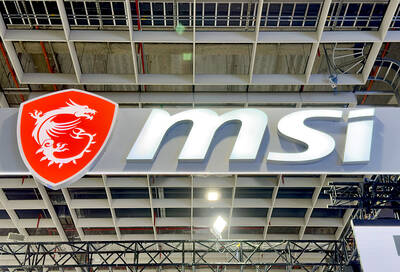In China’s volatile equity market, at least one thing has been a certainty: initial public offerings (IPOs) price low and then rally like crazy.
An unwritten valuation cap, imposed by the regulator, means listings all debut at about 23 times earnings or less.
Entrepreneurs have had no choice but to pocket an artificially low amount and then watch their shares soar by the daily limit, over and over again.
However, this defining — and distorting — characteristic of the US$7.3 trillion market might be about to change, at least for some companies.
Analysts say firms selling the first-ever Chinese depositary receipts (CDRs) would not be subject to the valuation restriction.
Xiaomi Corp (小米) is planning to raise US$5 billion, or half of its total offering, from the new type of security that is a high-profile attempt by Chinese officials to lure big tech firms home.
“They’ve got to relax the valuation caps otherwise CDRs won’t work,” said Ken Wong, a Hong Kong-based fund manager at Eastspring Investments (瀚亞投資), which manages about US$170 billion. “You can’t have these restrictive rules if you want to attract the biggest names in tech. It’s a step in the right direction.”
The China Securities Regulatory Commission did not immediately respond to a faxed request for comment on whether companies issuing CDRs would have more flexibility in pricing.
Authorities published the final rules for their trial program this month, less than three months after the CDR plan was first announced.
The urgency signals China’s desire to get its most innovative firms represented in its domestic equity market, which is clogged with state-controlled dinosaurs even though China has produced some of the world’s biggest tech businesses.
Although Chinese retail investors have been able to buy shares of Hong Kong-listed firms such as Tencent Holdings Ltd (騰訊) through an exchange link with Shanghai since 2014, it is much more difficult for them to trade stocks in the US.
That is where locally cultivated technology stars like Alibaba Group Holding Ltd (阿里巴巴), Baidu Inc (百度) or NetEase Inc (網易) have opted to list.
Those decisions were at least in part because of China’s rules for IPOs, which also include a ban on dual-class structures and an approval process that has spawned a 300-plus backlog of wannabe listings.
They were designed to protect individuals from buying into suspect companies at inflated prices.
In practice, the chokehold on supply and pricing, as well as the implicit government endorsement, created an investment on which it is impossible to lose.
This year, all 49 new listings soared by the 44 percent limit on the first day of trading and many kept surging for weeks after that.
With CDRs, China is trying to do it differently. Officials have approved six mutual funds that might raise nearly US$50 billion to purchase the securities, locking in cornerstone investors for three years and making it more difficult for punters to flip the stock.
The regulator has said it “hopes” that the market would not engage in speculation, and the government said that it would not guarantee returns or the quality of candidates.
Firms that opt to bypass retail altogether and sell shares exclusively to institutions and high-net-worth individuals would enjoy a simpler and speedier approval, effectively allowing sophisticated investors to take on a greater role in the pricing process, Goldman Sachs Group Inc said.
After Xiaomi’s debut, China’s restaurant review and delivery giant Meituan Dianping (美團點評) — which plans to file for an IPO of about US$6 billion in Hong Kong as soon as this month — is considered a prime candidate to sell shares in China.
The CDR trial “can also be seen as a key reform measure of introducing global best practices to the local market, notably the new IPO approval process and pricing mechanism,” analysts at Goldman Sachs wrote in a note this week.
CDR valuations might be higher than those of their underlying stocks in New York or Hong Kong, because Chinese investors have few alternatives if they want a slice of a global tech champion, Morgan Stanley said.
The sector, which makes up about 40 percent of the MSCI China gauge tracking offshore shares, is about 10 percent of a measure tracking A shares. Alibaba trades at about 30 times forward earnings.
“Tech stocks have historically been more expensive onshore and they represent scarce assets in that market, but there’s still so much more information that needs to be disclosed on the technical, regulatory and trading side for us to really understand the scale of that gap,” Morgan Stanley equity strategist Laura Wang said by telephone from Hong Kong.

Meta Platforms Inc offered US$100 million bonuses to OpenAI employees in an unsuccessful bid to poach the ChatGPT maker’s talent and strengthen its own generative artificial intelligence (AI) teams, OpenAI CEO Sam Altman has said. Facebook’s parent company — a competitor of OpenAI — also offered “giant” annual salaries exceeding US$100 million to OpenAI staffers, Altman said in an interview on the Uncapped with Jack Altman podcast released on Tuesday. “It is crazy,” Sam Altman told his brother Jack in the interview. “I’m really happy that at least so far none of our best people have decided to take them

BYPASSING CHINA TARIFFS: In the first five months of this year, Foxconn sent US$4.4bn of iPhones to the US from India, compared with US$3.7bn in the whole of last year Nearly all the iPhones exported by Foxconn Technology Group (富士康科技集團) from India went to the US between March and last month, customs data showed, far above last year’s average of 50 percent and a clear sign of Apple Inc’s efforts to bypass high US tariffs imposed on China. The numbers, being reported by Reuters for the first time, show that Apple has realigned its India exports to almost exclusively serve the US market, when previously the devices were more widely distributed to nations including the Netherlands and the Czech Republic. During March to last month, Foxconn, known as Hon Hai Precision Industry

PLANS: MSI is also planning to upgrade its service center in the Netherlands Micro-Star International Co (MSI, 微星) yesterday said it plans to set up a server assembly line at its Poland service center this year at the earliest. The computer and peripherals manufacturer expects that the new server assembly line would shorten transportation times in shipments to European countries, a company spokesperson told the Taipei Times by telephone. MSI manufactures motherboards, graphics cards, notebook computers, servers, optical storage devices and communication devices. The company operates plants in Taiwan and China, and runs a global network of service centers. The company is also considering upgrading its service center in the Netherlands into a

Taiwan’s property market is entering a freeze, with mortgage activity across the nation’s six largest cities plummeting in the first quarter, H&B Realty Co (住商不動產) said yesterday, citing mounting pressure on housing demand amid tighter lending rules and regulatory curbs. Mortgage applications in Taipei, New Taipei City, Taoyuan, Taichung, Tainan and Kaohsiung totaled 28,078 from January to March, a sharp 36.3 percent decline from 44,082 in the same period last year, the nation’s largest real-estate brokerage by franchise said, citing data from the Joint Credit Information Center (JCIC, 聯徵中心). “The simultaneous decline across all six cities reflects just how drastically the market